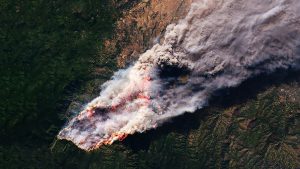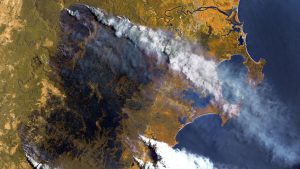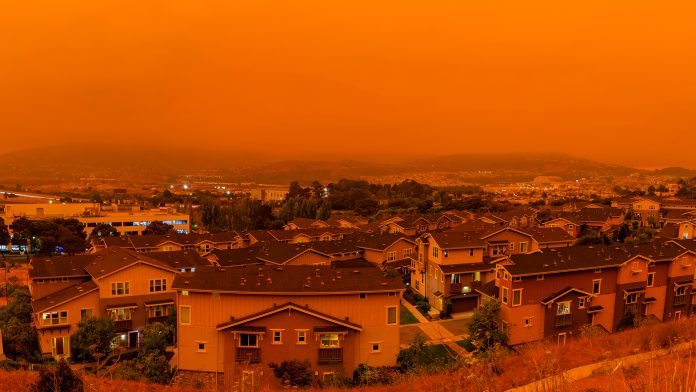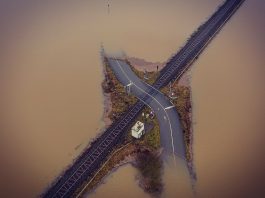As climate change brings more natural disasters, the after-effects of those disasters must also be considered. RSS-Hydro discusses the effects of post-wildfire flooding, and what can be done to prepare for and mitigate the impact of those flooding waters.
Wildfires, the uncontrolled burning of vegetation, have become increasingly prevalent in recent years, leaving a trail of destruction in their wake. One of the most concerning consequences of wildfires is the heightened risk of post-fire flooding, a natural hazard that poses a significant threat to communities, infrastructure, and the environment.
Understanding the hazard: A landscape transformed
Post-fire flooding is linked to the profound alterations that wildfires inflict on the landscape. Removing vegetation, once a crucial shield against erosion and runoff, leaves the soil bare and exposed to the erosive power of rainwater. This can lead to the formation of a hydrophobic layer, a water-repellent film on the soil surface that further impedes water infiltration and increases surface runoff.
Flooding in burned areas, also known as post-wildfire flooding or flash flooding, is a natural hazard that can occur when wildfires remove vegetation, expose soil, and create a hydrophobic layer that prevents soil from absorbing water effectively. This can lead to a rapid increase in runoff, particularly during heavy rainfall events, which can cause flash floods, landslides, and erosion. In August 2023, Greece experienced devastating floods exacerbated by the previous year’s wildfires. A series of intense rainfall events triggered widespread flooding and mudslides in several regions, including Attica, Peloponnese, and the islands of Evia and Lesbos. These floods caused widespread damage to property and infrastructure, resulted in the loss of multiple lives, and displaced thousands of people. The floods were attributed to a combination of factors, including heavy rainfall, the impenetrable nature of burned soils, and wildfire debris. This event is a stark reminder of the significant threat posed by post-fire flooding and the importance of developing effective mitigation strategies.
The devastating impacts: A multifaceted threat
Post-fire flooding unleashes a cascade of destructive impacts, disrupting lives and ecosystems alike. Post-fire flooding is a natural hazard that can have devastating consequences. Wildfires can remove vegetation, expose soil, and create a hydrophobic layer that prevents soil from absorbing water effectively. This can lead to a rapid increase in runoff, particularly during heavy rainfall events, which can cause flash floods, landslides, and erosion. Flash floods and sudden and intense water surges carry debris and mud, wreaking havoc on property, infrastructure, and roads. The sheer force of these floods can endanger lives and disrupt transportation networks.
Landslides, another consequence of post-fire flooding, are triggered when heavy rainfall saturates the weakened and unstable soils, causing them to slide downhill. These landslides can occur at an alarming speed, posing a serious threat to communities residing in lower elevations. Erosion, the wearing away of land surfaces by water, is exacerbated by post-fire flooding. The rapid runoff of water dislodges soil particles, carrying them downstream and altering the flow of rivers and streams. This erosion damages waterways and degrades the land, disrupting natural habitats and ecosystems. In addition to these immediate impacts, ash concentrations can be mobilised in flood flows, contaminating drinking water supplies. This poses a significant threat to public health and can require extensive water treatment efforts to ensure safe drinking water.
Ash from wildfires can contain harmful substances, including heavy metals, arsenic, and polycyclic aromatic hydrocarbons (PAHs). When ash-contaminated floodwaters enter reservoirs, these contaminants can potentially migrate into drinking water supplies. Ash particles can also clog filters and interfere with water treatment processes, making it more difficult to remove harmful substances.
Exposure to ash-contaminated drinking water can pose a variety of health risks. Heavy metals can cause neurological, developmental, and reproductive problems. Arsenic can lead to cancer, skin diseases, and cardiovascular problems. PAHs can cause cancer, respiratory problems, and immune system damage. Mitigating the risk of post-fire flooding requires a comprehensive approach encompassing strategies to reduce the impact of wildfires and enhance the resilience of communities in burned areas.

Reducing the impact of wildfires: A preventive measure
Controlled burns, prescribed fire management, and forest thinning are effective strategies for reducing the severity of wildfires and their impact on the landscape. Controlled burns, conducted under controlled conditions, help to eliminate excess fuel and create firebreaks, reducing the risk of wildfires spreading uncontrollably. Prescribed fire management involves setting controlled fires at specific times and locations to reduce the overall fuel load in an area. Forest thinning, the selective removal of trees in dense forests, creates a more open landscape less susceptible to fire, reducing the risk of debris flows and erosion.
Enhancing community resilience: Building back stronger
The re-establishment of vegetation cover is crucial for restoring the natural protection against erosion and runoff. Revegetation efforts, involving planting trees, shrubs, and other plants in burned areas, help to improve soil infiltration and reduce the risk of flooding. Soil stabilisation techniques, such as using mulch, compost, and other materials to cover the soil, can further enhance soil infiltration and reduce the formation of hydrophobic layers. Early detection and suppression efforts, relying on an active wildfire monitoring network and rapid response teams, are critical in limiting the spread of wildfires and minimising the extent of burned areas.

Leveraging emerging satellite technologies: Advancing disaster preparedness
Satellites are playing an increasingly important role in wildfire monitoring and prediction. They can detect fires early, provide real-time information on their extent and intensity, and help firefighters predict how fires will spread. Such information can be complemented by on-the-ground sensor technology and hydrodynamic modelling, a powerful tool for simulating water flow and predicting flooding in burned landscapes. Such simulations provide valuable insights for land-use planning and infrastructure development. Satellite sensors can also provide real-time data on rainfall patterns, soil moisture, and vegetation cover. They can identify areas at high risk of flooding and trigger early warning systems and evacuation orders.
A call to action: Embracing sustainable practices
Addressing the growing threat of post-fire flooding requires a collective effort from individuals, communities, and governments. Adopting sustainable practices, such as reducing deforestation and implementing prescribed fire management, can help to reduce the risk of wildfires and their devastating consequences. Investing in early warning systems, flood mitigation infrastructure, and reforestation efforts can further enhance resilience and protect communities from the destructive forces of post-fire flooding.
As climate change continues exacerbating the frequency and intensity of wildfires, the need for effective mitigation strategies for post-fire flooding becomes increasingly urgent. By understanding the underlying causes of this hazard and exploring innovative solutions, we can work towards a future where communities are better prepared to face the challenges posed by post-fire flooding and safeguard lives, property, and the environment.
At RSS-Hydro, we research and develop innovative water risk management solutions that combine computer modelling and satellite Earth Observation technologies to help communities, governments and industry become more resilient and be better prepared when facing disaster.
Please note, this article will also appear in the seventeenth edition of our quarterly publication.









